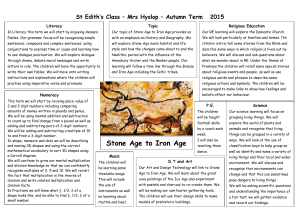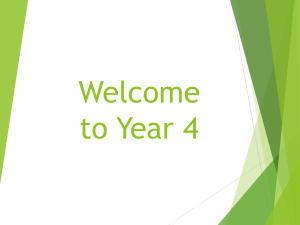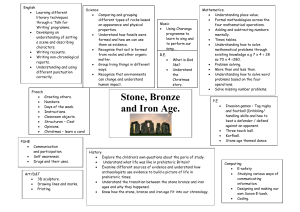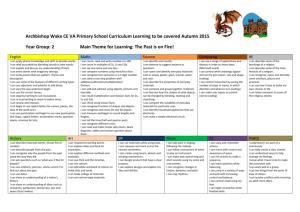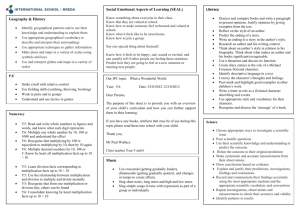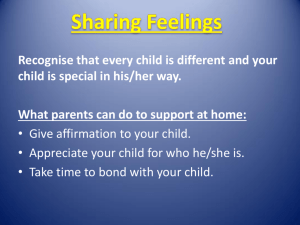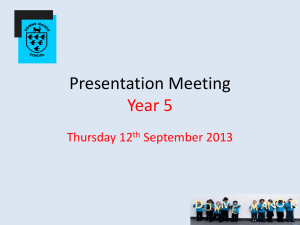Document
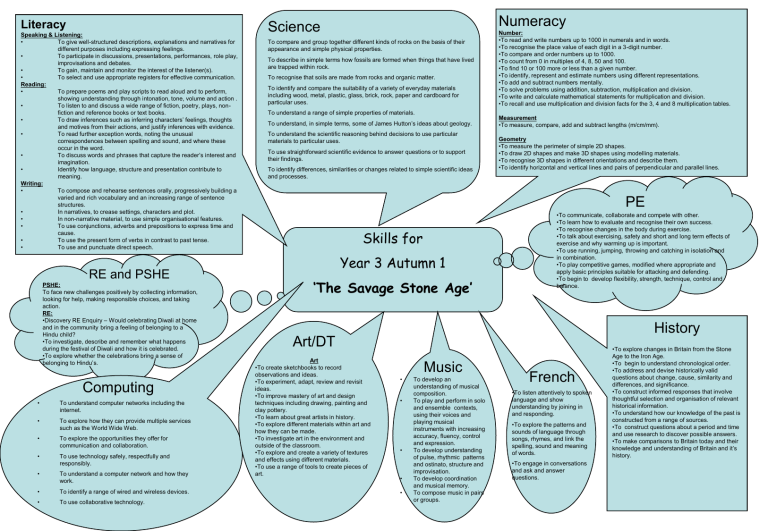
•
•
•
•
•
•
•
•
•
•
•
Literacy
Speaking & Listening:
•
To give well-structured descriptions, explanations and narratives for
•
•
Reading:
• different purposes including expressing feelings.
To participate in discussions, presentations, performances, role play, improvisations and debates.
To gain, maintain and monitor the interest of the listener(s).
To select and use appropriate registers for effective communication.
To prepare poems and play scripts to read aloud and to perform, showing understanding through intonation, tone, volume and action .
To listen to and discuss a wide range of fiction, poetry, plays, nonfiction and reference books or text books.
To draw inferences such as inferring characters’ feelings, thoughts and motives from their actions, and justify inferences with evidence.
To read further exception words, noting the unusual correspondences between spelling and sound, and where these occur in the word.
To discuss words and phrases that capture the reader’s interest and imagination.
Identify how language, structure and presentation contribute to meaning.
Writing:
•
To compose and rehearse sentences orally, progressively building a varied and rich vocabulary and an increasing range of sentence structures.
In narratives, to crease settings, characters and plot.
In non-narrative material, to use simple organisational features.
To use conjunctions, adverbs and prepositions to express time and cause.
To use the present form of verbs in contrast to past tense.
To use and punctuate direct speech.
•
•
•
•
•
•
•
RE and PSHE
PSHE:
To face new challenges positively by collecting information, looking for help, making responsible choices, and taking action.
RE:
•Discovery RE Enquiry – Would celebrating Diwali at home and in the community bring a feeling of belonging to a
Hindu child?
•To investigate, describe and remember what happens during the festival of Diwali and how it is celebrated.
•To explore whether the celebrations bring a sense of belonging to Hindu’s.
Computing
To understand computer networks including the internet.
To explore how they can provide multiple services such as the World Wide Web.
To explore the opportunities they offer for communication and collaboration.
To use technology safely, respectfully and responsibly.
To understand a computer network and how they work.
To identify a range of wired and wireless devices.
To use collaborative technology.
Science
To compare and group together different kinds of rocks on the basis of their appearance and simple physical properties.
To describe in simple terms how fossils are formed when things that have lived are trapped within rock.
To recognise that soils are made from rocks and organic matter.
To identify and compare the suitability of a variety of everyday materials including wood, metal, plastic, glass, brick, rock, paper and cardboard for particular uses.
To understand a range of simple properties of materials.
To understand, in simple terms, some of James Hutton’s ideas about geology.
To understand the scientific reasoning behind decisions to use particular materials to particular uses.
To use straightforward scientific evidence to answer questions or to support their findings.
To identify differences, similarities or changes related to simple scientific ideas and processes.
Skills for
Year 3 Autumn 1
‘The Savage Stone Age’
Art/DT
Art
•To create sketchbooks to record observations and ideas.
•To experiment, adapt, review and revisit ideas.
•To improve mastery of art and design techniques including drawing, painting and clay pottery.
•To learn about great artists in history.
•To explore different materials within art and how they can be made.
•To investigate art in the environment and outside of the classroom.
•To explore and create a variety of textures and effects using different materials.
•To use a range of tools to create pieces of art.
•
•
•
•
•
Music
To develop an understanding of musical composition.
To play and perform in solo and ensemble contexts, using their voices and playing musical instruments with increasing accuracy, fluency, control and expression.
To develop understanding of pulse, rhythmic patterns and ostinato, structure and improvisation.
To develop coordination and musical memory.
To compose music in pairs or groups.
Numeracy
Number:
•To read and write numbers up to 1000 in numerals and in words.
•To recognise the place value of each digit in a 3-digit number.
•To compare and order numbers up to 1000.
•To count from 0 in multiples of 4, 8, 50 and 100.
•To find 10 or 100 more or less than a given number.
•To identify, represent and estimate numbers using different representations.
•To add and subtract numbers mentally.
•To solve problems using addition, subtraction, multiplication and division.
•To write and calculate mathematical statements for multiplication and division.
•To recall and use multiplication and division facts for the 3, 4 and 8 multiplication tables.
Measurement
•To measure, compare, add and subtract lengths (m/cm/mm).
Geometry
•To measure the perimeter of simple 2D shapes.
•To draw 2D shapes and make 3D shapes using modelling materials.
•To recognise 3D shapes in different orientations and describe them.
•To identify horizontal and vertical lines and pairs of perpendicular and parallel lines.
•To communicate, collaborate and compete with other.
•To learn how to evaluate and recognise their own success.
•To recognise changes in the body during exercise.
•To talk about exercising, safety and short and long term effects of exercise and why warming up is important.
•To use running, jumping, throwing and catching in isolation and in combination.
•To play competitive games, modified where appropriate and apply basic principles suitable for attacking and defending.
•To begin to develop flexibility, strength, technique, control and balance.
French
•To listen attentively to spoken language and show understanding by joining in and responding.
•To explore the patterns and sounds of language through songs, rhymes, and link the spelling, sound and meaning of words.
•To engage in conversations and ask and answer questions.
PE
History
•To explore changes in Britain from the Stone
Age to the Iron Age.
•To begin to understand chronological order.
•To address and devise historically valid questions about change, cause, similarity and differences, and significance.
•To construct informed responses that involve thoughtful selection and organisation of relevant historical information.
•To understand how our knowledge of the past is constructed from a range of sources.
•To construct questions about a period and time and use research to discover possible answers.
•To make comparisons to Britain today and their knowledge and understanding of Britain and it’s history.
•
Literacy
•
Instructions: George’s Marvellous Medicine
Discuss and research the life of Roald Dahl.
Research the features, structure and layout of instructions.
•
•
Evaluate and examine a range of instruction.
Explore imperative verbs and time
•
•
•
•
• connectives.
Instructions for an alien – write and follow
Plan and write instructions for George.
Explore suffixes.
•
•
Poems to perform: Revolting Rhymes
Introduction to poetry and it’s different forms.
Explore alliteration, rhyme, repetition and spelling patterns.
Examine performance and creativity using tone, volume and action.
Create and perform a rhyme of their own.
•
•
•
•
Stories with a realistic/familiar setting: Matilda
Create character profiles.
Debate
– Who is a better teacher?
Create a character of their own.
Make predictions within the story.
•
• Use speech bubbles and direct speech.
Create a police report.
•
Write an alternative ending.
ICT – word processing, editing, saving and retrieving.
Science
Observe, examine, name and sort rock samples.
Compare rock samples for wear and permeability.
Go on a “rock trail” to identify the ways rocks have been used.
Look at different types of fossils and examine the patterns.
Look at how fossils are formed.
How do we use fossil fuels?
Research James Hutton.
Create a model of the Earth’s structure.
Learn how soil is formed and describe soil samples.
ICT
– Secondary research and Investigation using data logging.
Activities for
Year 3 Autumn 1
‘The Savage Stone Age’
RE and PSHE
•PSHE– Transitions and KS2 (E.g. A new class, rules, friendships, worries and anxieties).
•Enquiry Question – Would celebrating Diwali at home and in the community bring a feeling of belonging to a Hindu Child?
•Does participating in worship help people feel closer to God or their faith community?
Art
•Explore cave paintings including compositions, styles, meanings, colours, tools and blending techniques.
Music
•Make paints using fruits, berries and chalk pastels.
•Explore rock etching using clay and paints.
•Investigate outdoor art – e.g. textures, colours, and the use of petals, soil and leaves to create art materials.
•ICT - Research Lin Wellford (Rock Artist).
•Explore pottery – create a bowl/ pot using clay.
Exploring rhythmic patterns
•Clapping pulses and rhythms
•Exploring Ostinato (a repeated pattern)
•Use tuned and un-tuned percussion instruments
•Compose and perform music in pairs and groups
•Exploring how to record their own compositions.
ICT – sound recording
Numeracy
•Read, write and order two and three digit numbers in both words and numerals.
•Understand what each digit is worth and partition numbers.
•Round two- and three- digit numbers to the nearest 10.
•Compare two- and three-digit numbers using < and >.
•Count on or back in steps of 10, 20, 30, 40, 50, 80 and 100.
•Say and record numbers that are 1, 10 or 100 more or less than a number.
•Use partitioning to mentally add and subtract two-digit numbers and ones.
•Solve missing number and word problems.
•Recall and use multiplication facts for the two-, four- , five-, eight, and ten-times tables.
•Use known facts to multiply and divide two-digit by one-digit numbers mentally.
•Revise division as repeated subtraction.
•Know the relationship between mm, cm and m.
•Measure and draw lines using a ruler to the nearest half cm and nearest mm and measure accurately to the nearest m or cm using a metre ruler.
•Compare, add and subtract lengths.
•Recognise, draw and describe 2D and 3D.
•ICT – function machines and spreadsheets and “turtles” to create different shapes.
French
•Greetings
•Asking and answering how are you
•Asking for and giving your name and age
•Numbers 1-10
PE
Games/ Invasion Games:
Ball skills invasion focus
Netball skills
Athletics:
Running, jumping and throwing
Combinations of all three
History
•Explore changes in Britain from the Stone Age to the Iron Age.
•Make comparisons to today.
•Research Bronze Age religions, technology and travel.
•Explore Stone Henge, a Stone
Age Village and artefacts.
•Look at Late Neolithic huntergatherers and early farmers (e.g.
Skara Brae).
•Create a timeline.
•Explore the changes from the
Stone Age to the Bronze Age.
•ICT – Research using historical sites.
